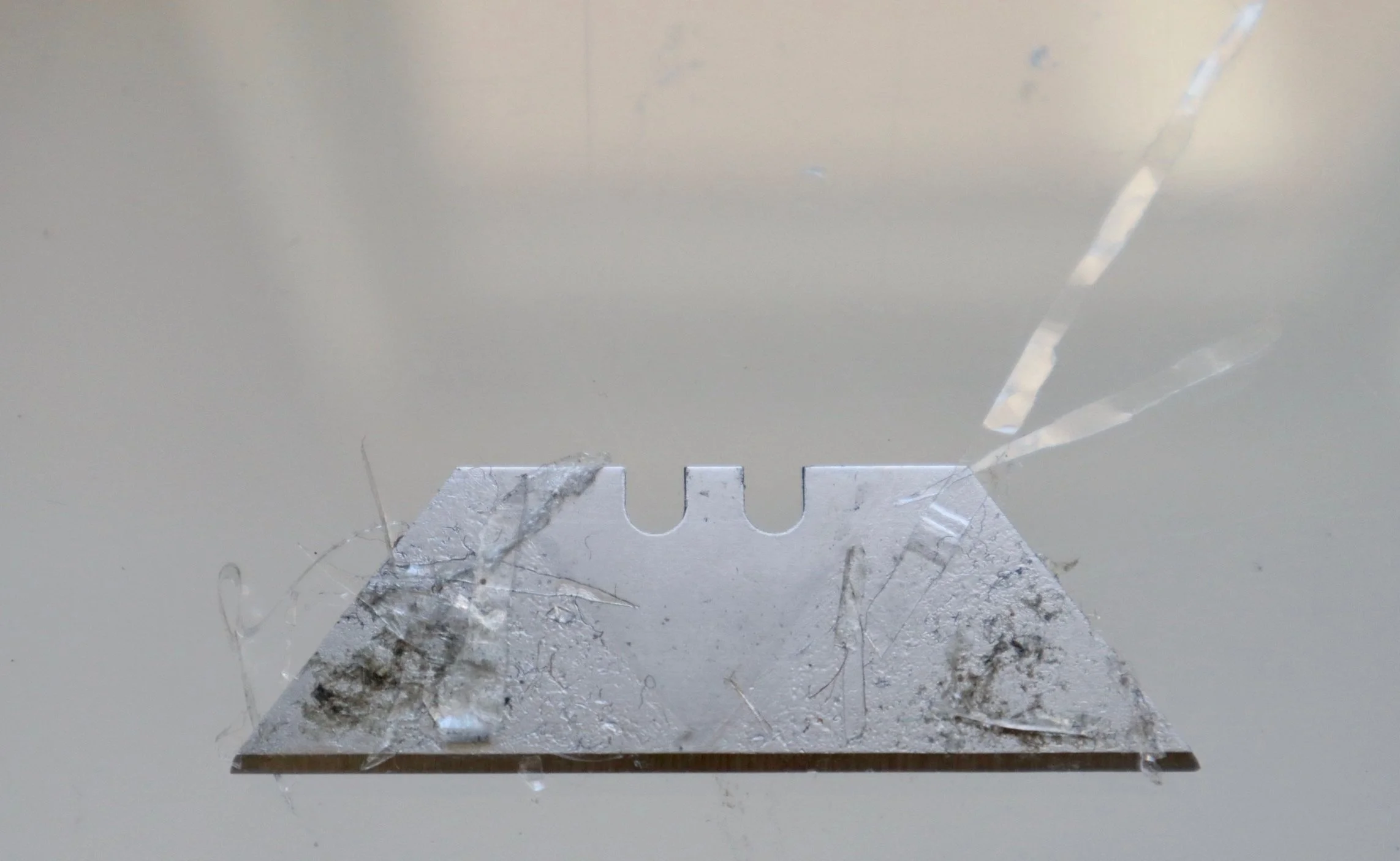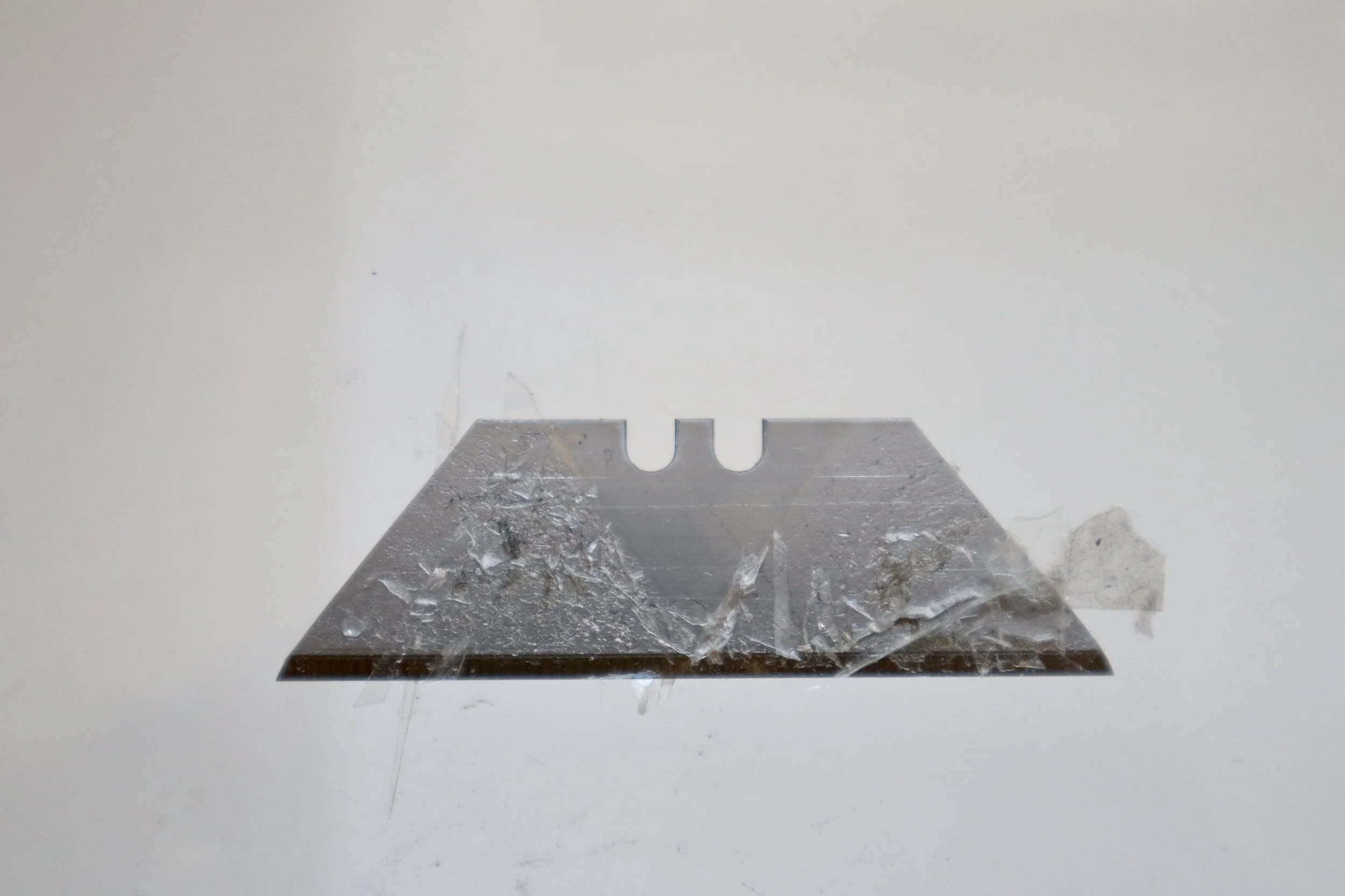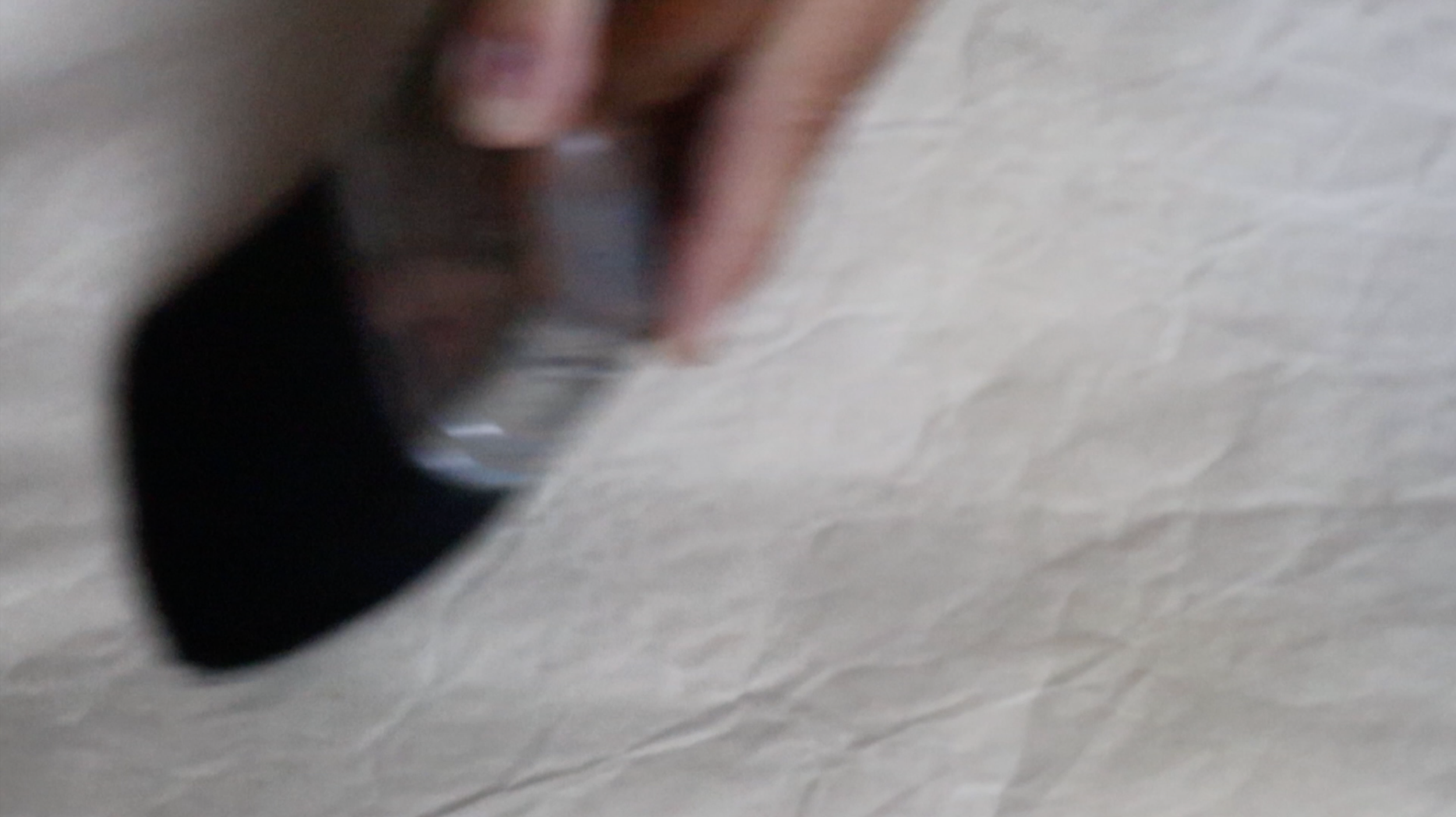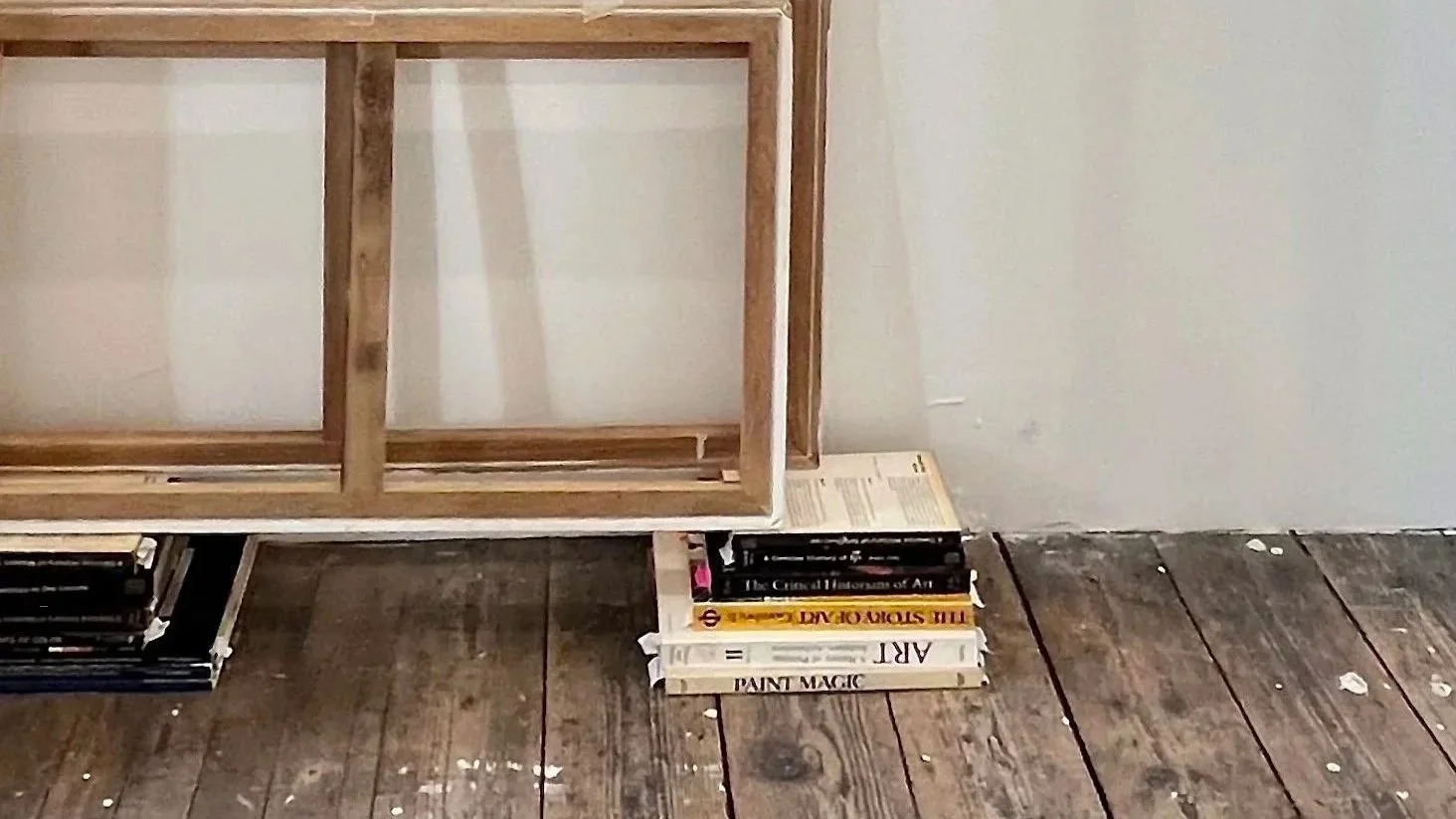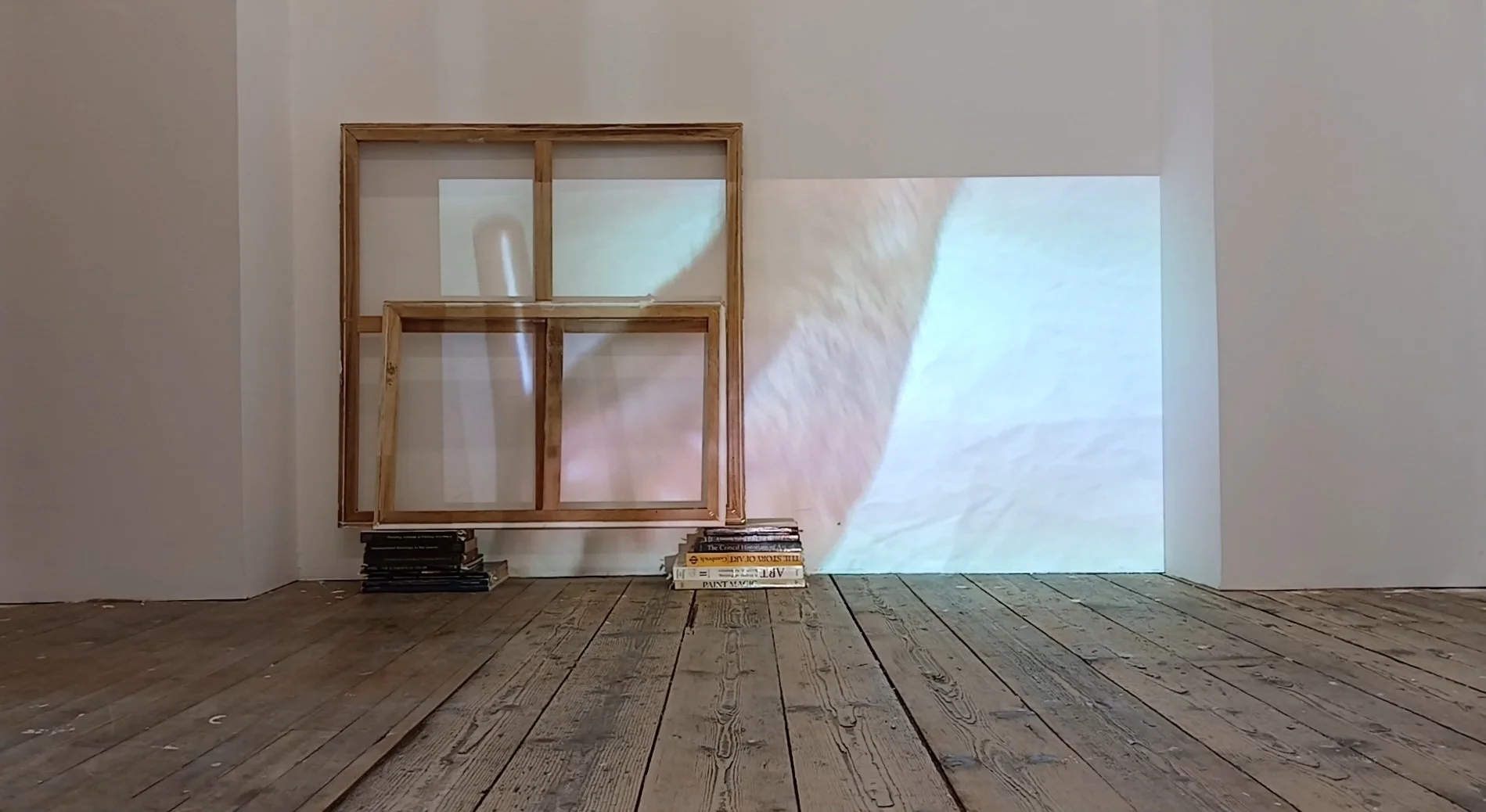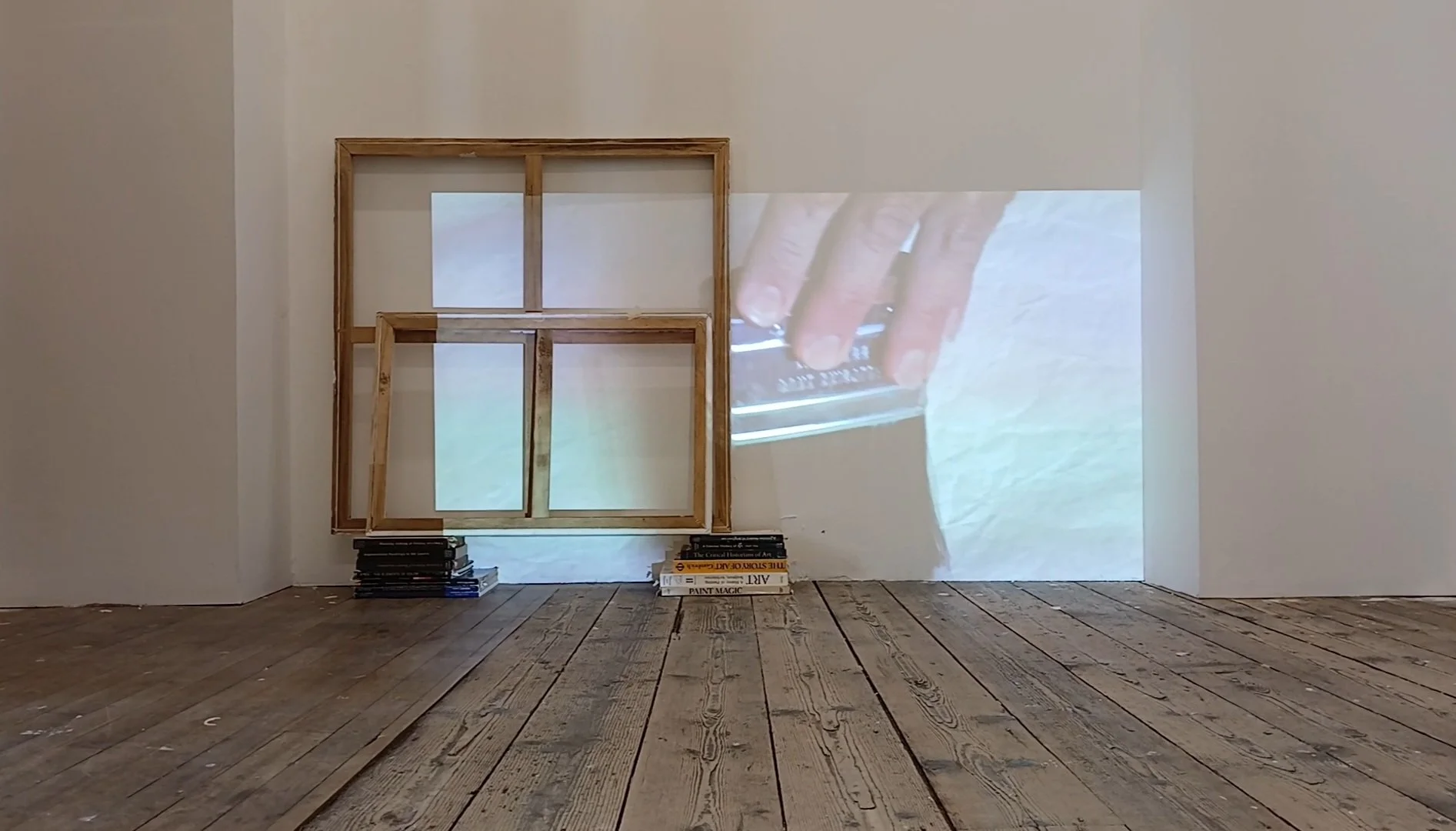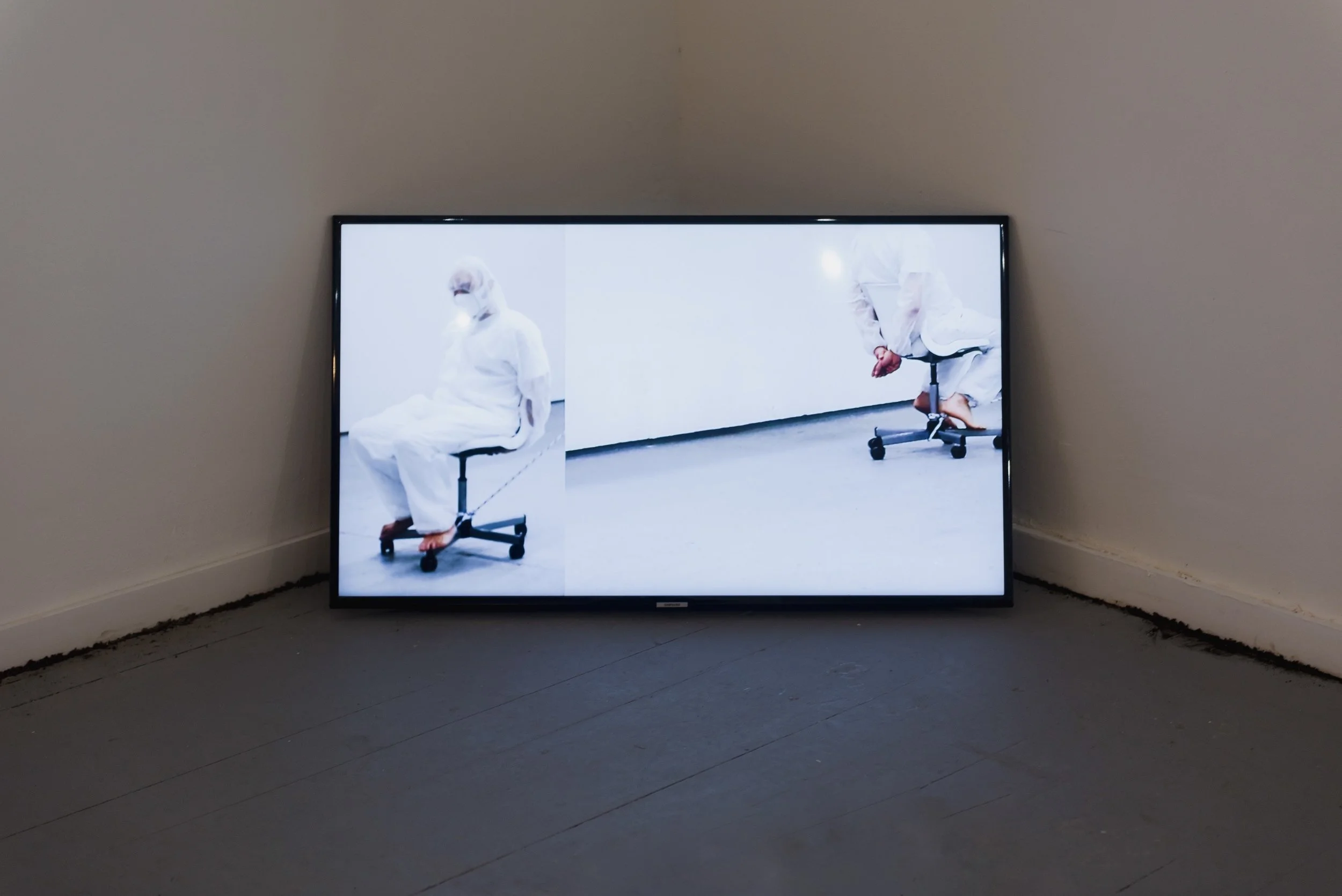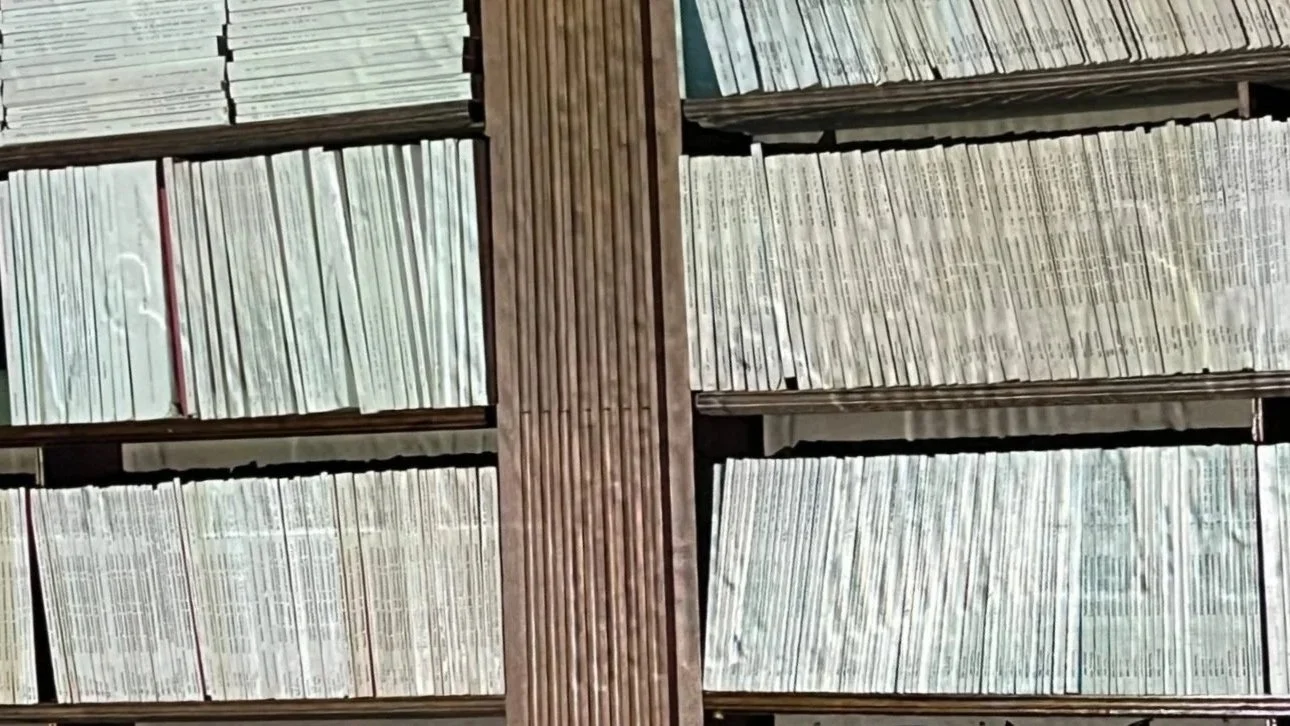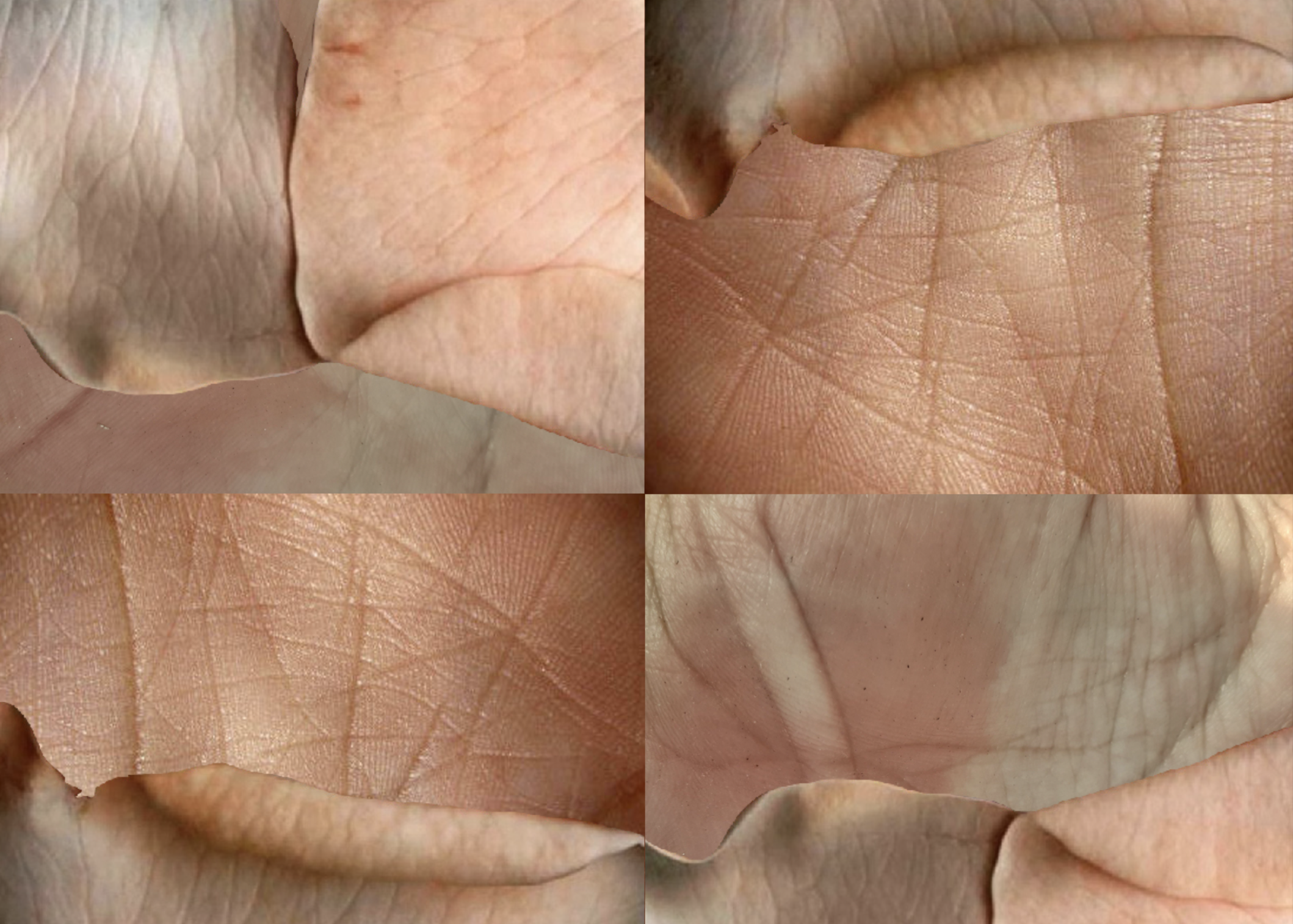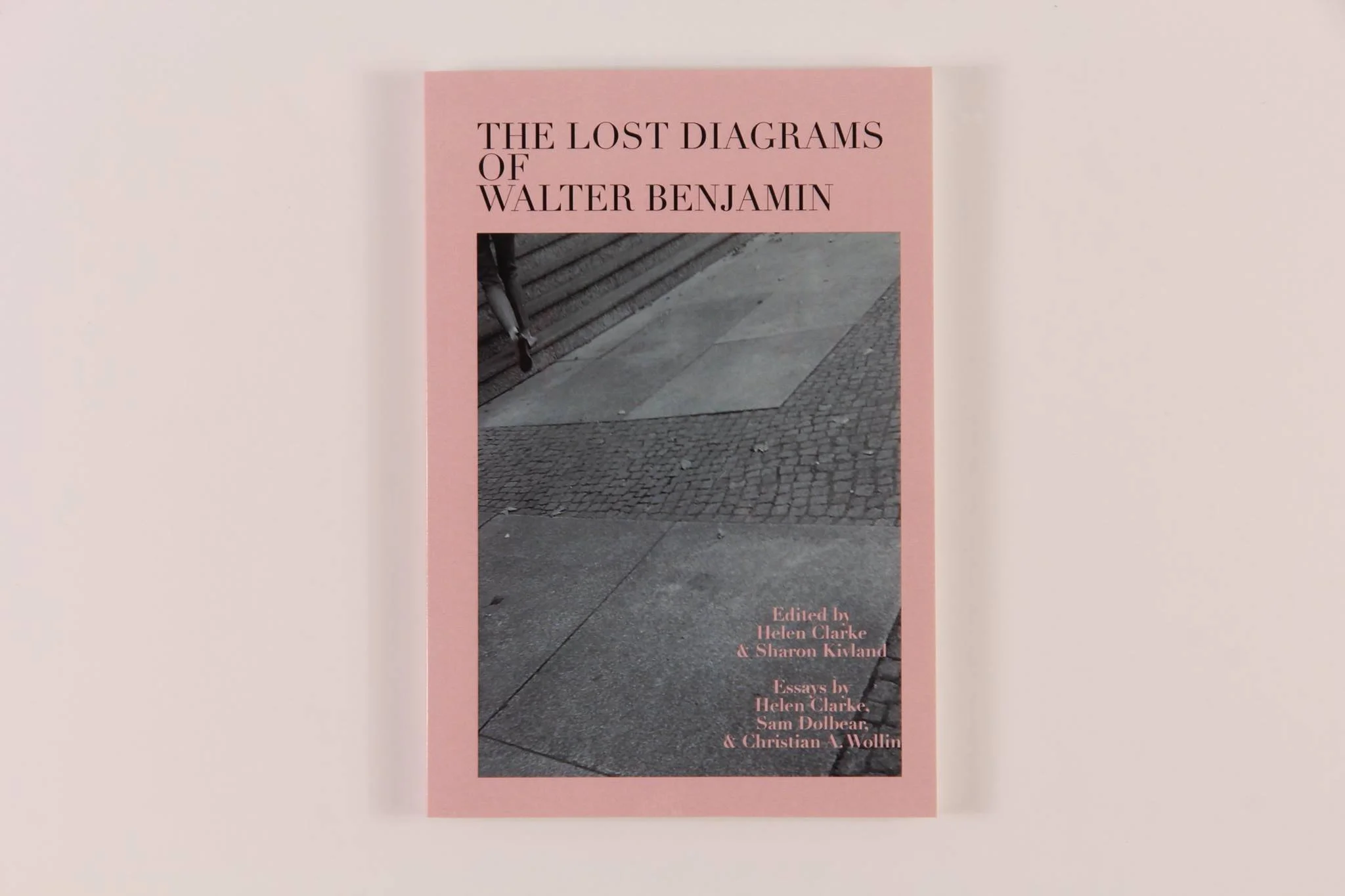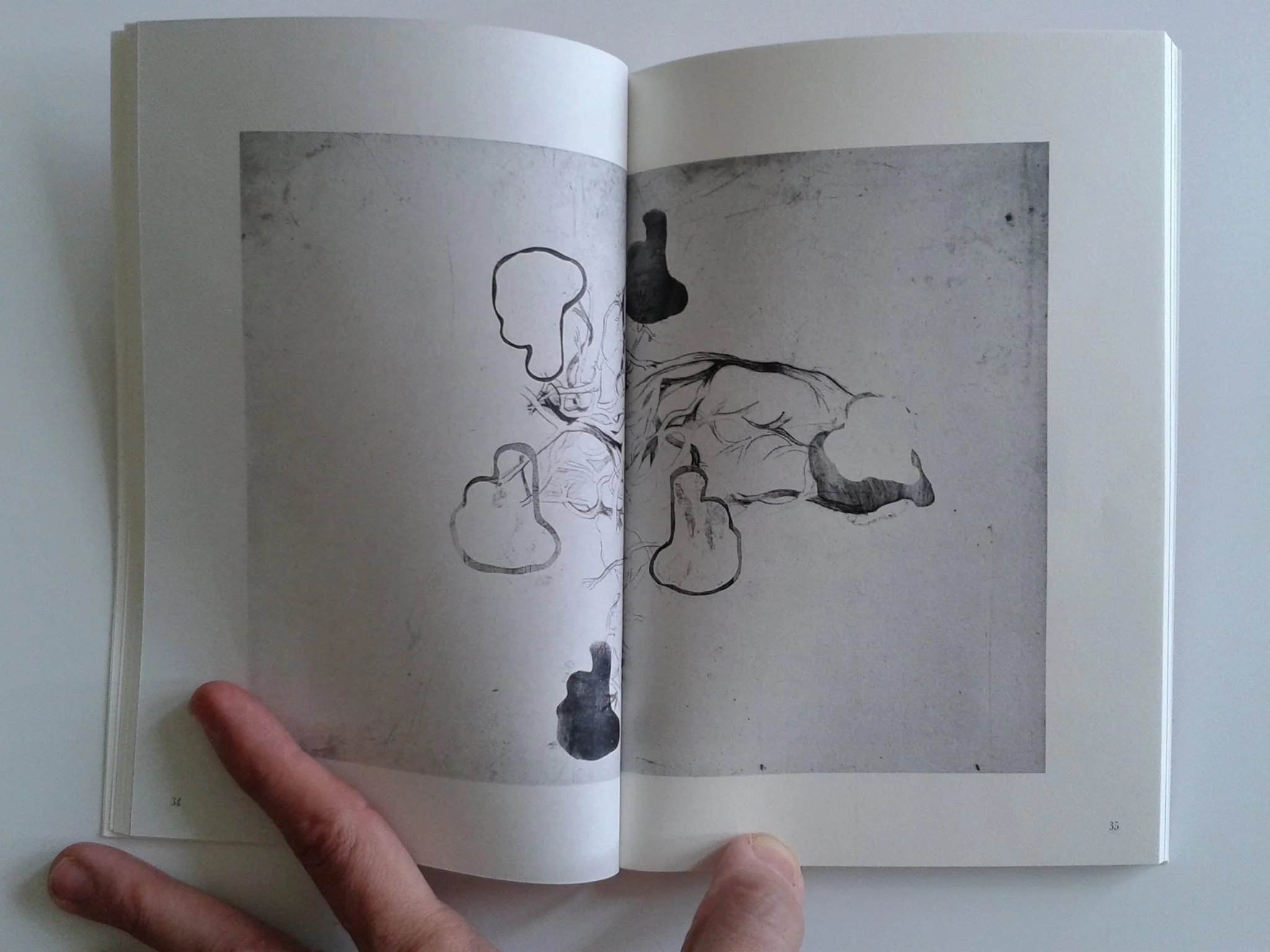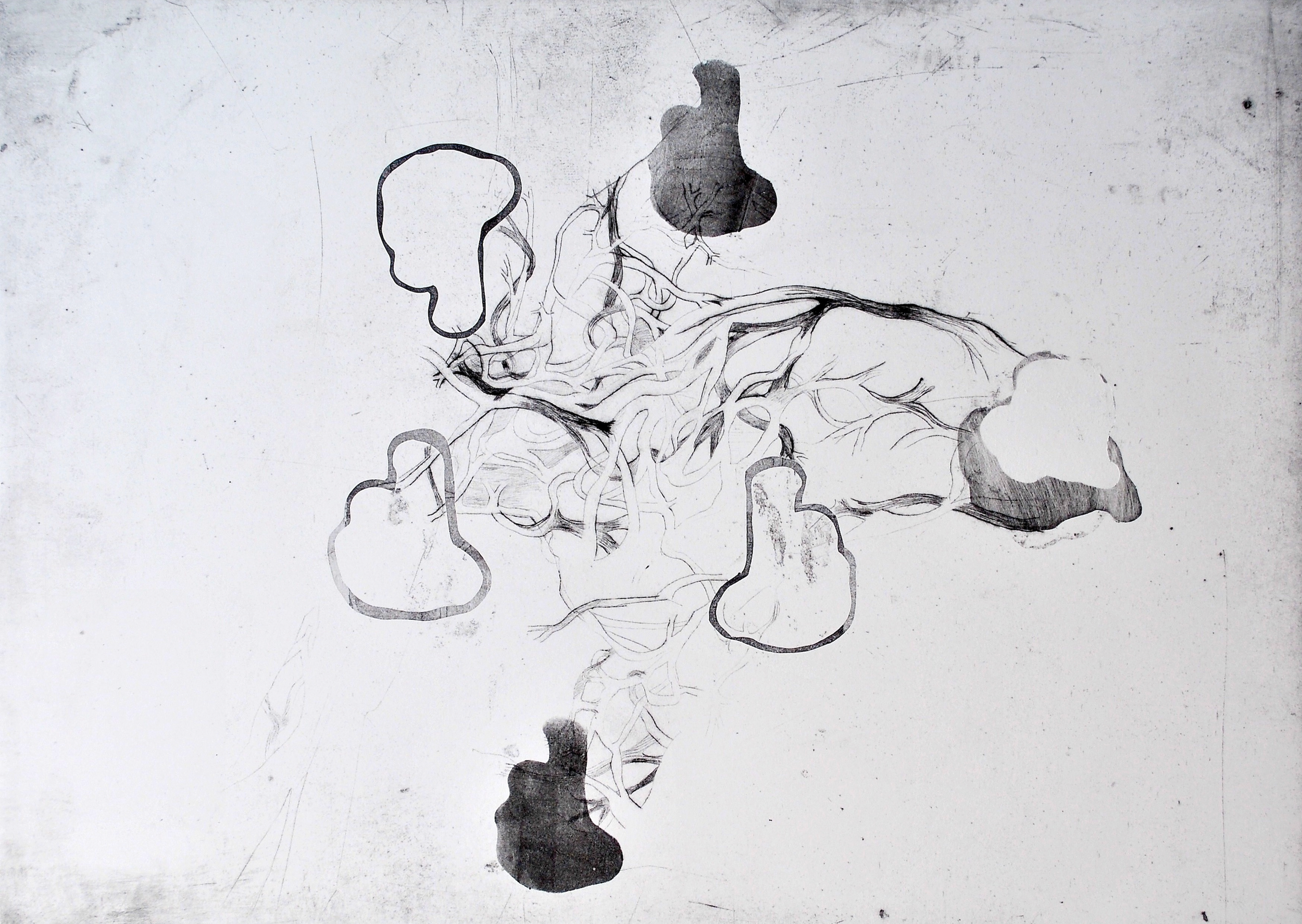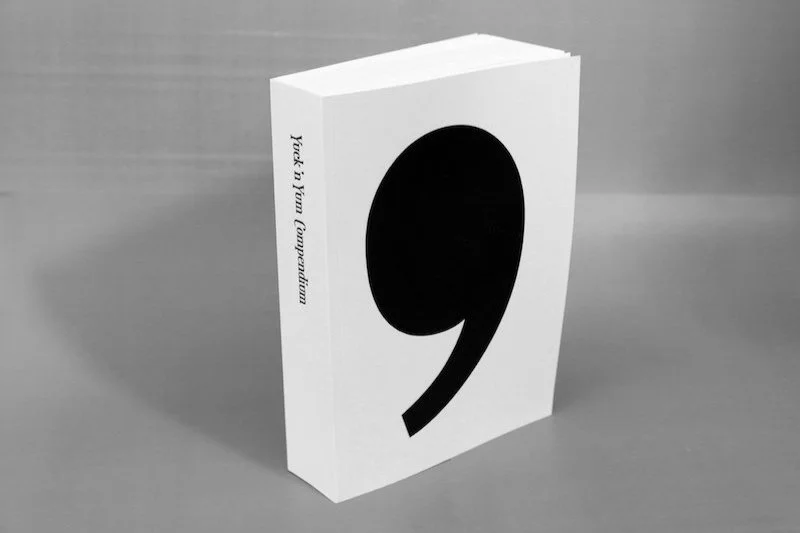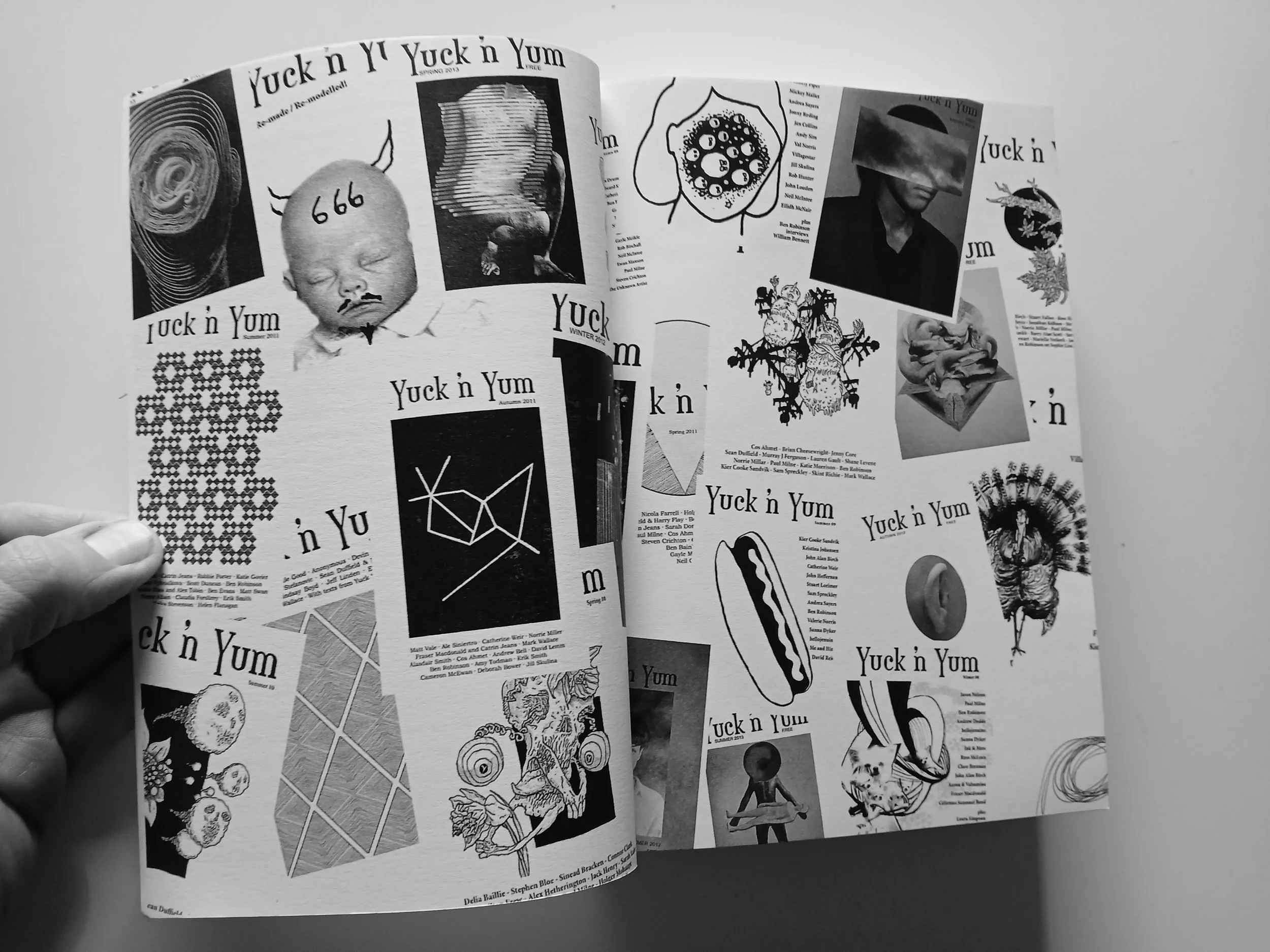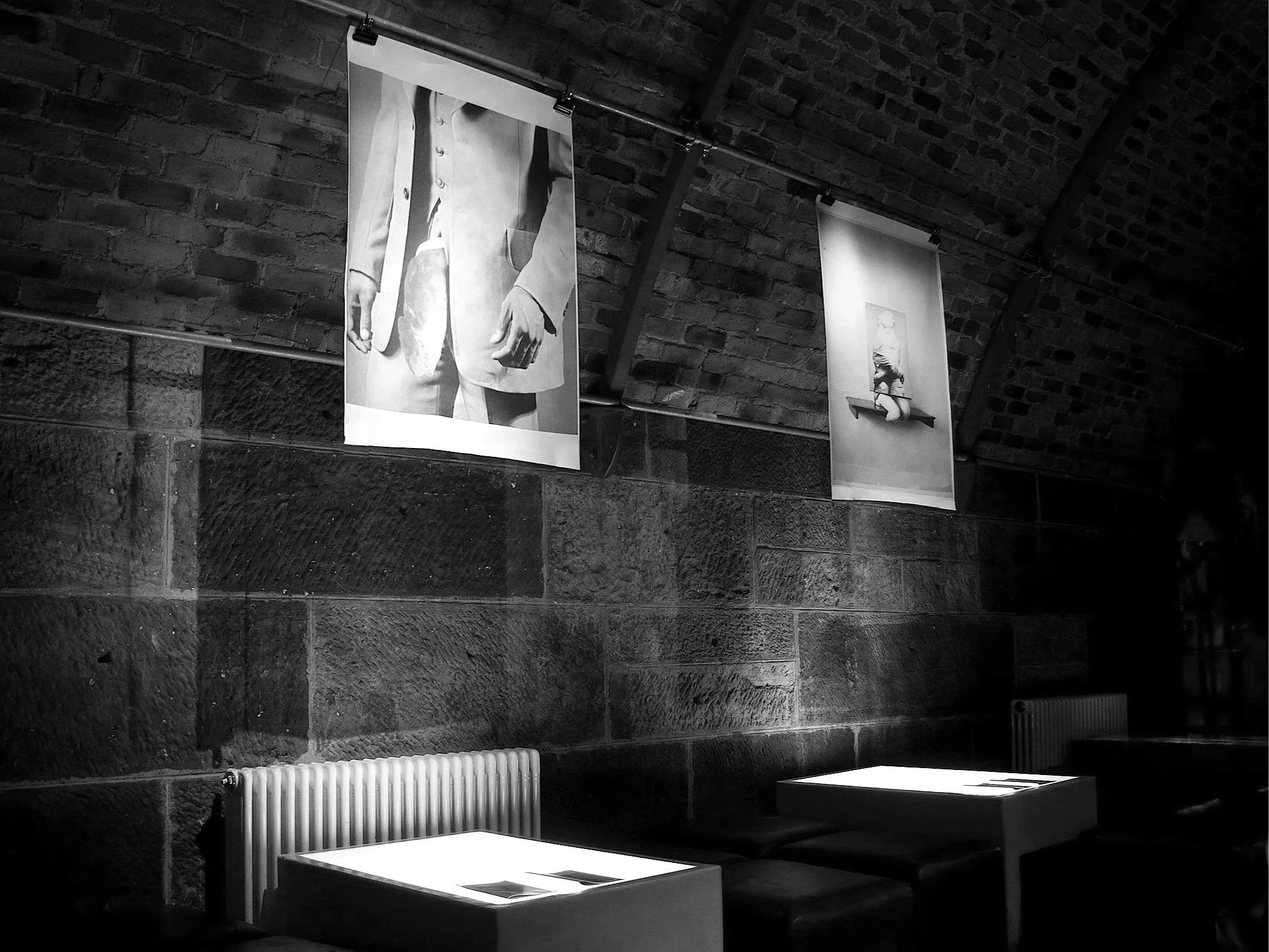I recently completed a year long programme with Conditions, led by Matthew-Noel Tod, under the mentorship of Conditions Associate and Vienna-based artist, James Lewis.
During part of this time, I took the brave decision to destroy previous works — principally all the works I made out of clear packing tape and clear pvc film (spanning works from 2020 -2023), in an attempt to return the material back to its origins. Over the period of several months, the dismantling of works resulted in an ongoing series of works called ‘4.8038206872’, with each part of this small series holding an additional title in brackets, denoting the stages to this protracted project — (incision); (inversion); (residue); and (damage). The significant function to the project became, not only the erasure of certain works from my oeuvre, but the erasure of the presence of a body from these works (as much as a body was needed to implement these motions), allowed for the invisible actions and enactments that a body carries out, to become the principle element in the creation of these pieces. What emerged is a kind of indexical casting of these invisible gestures, which is explained further in each of the stages below.
The long number ‘4.8038206872’ used, makes reference to the statistical data attached to the quantity of clear packing tape and clear pvc used — in this case expressed in miles, contributing to the making of the previous works (that included sculpture, choreographic objects and installations for performances - which now only exist as documentation). The series is perpetual and ongoing, much like its long number — a pattern of digits that repeats infinitely; repeating again and again in the making, all of which symbolises the undoing and redoing of a continuum, requiring further clear packing tape to be added and used, increasing the milage, where the title’s numerical display potentially and continually changes, arriving at it’s current (and uncertain) position of ‘4.8038206872’.
Only a very small amount of the previous works remain, purporting to the potential increase of the current mileage being used as this project’s title. Who can say whether the remainder will be converted and added to this series? It only seems fitting to the whole premise of the project to continue.
The following documentation, maps these works accounted journey and metamorphosis as they took place in this project as part of the development of my practice. The works that were destroyed to make this series, can be found in the gallery of works on this site.
4.8038206872 (incision)
Appointing a Stanley knife and its numerous blades seemed the best possible incising instrument to aid the cutting, splicing and dissecting of each clear tape object in the first stages of returning this 'object-material' back to its origin. The unexpected was revealed in the clear tape’s adhesive becoming congealed and stuck to the surface of each blade, where the tape has imparted, leaving traces of its own demise.
This act has in itself served to become another arm to this series, creating what can only be described as an 'aftermath' in the wake of the numerous hours of cutting and trimming the clear tape objects to fit the 211 spools dimensions. This added an extra layer of the indexical and haptical relationship to material, as a proposition for the counterparts in this small series, transforming these consumable products to oscillate into something less neutral, or material, but into objects.
Photographic documentation of 4.8038206872 (incision), 12 knife blades, clear tape and tape adhesive, pvc film residue, cardboard dust, hair, skin, fibres. Dimensions: 5.5cm x 2cm and 6cm x 5cm (including blade and residual matter)
4.8038206872 (inversion)
Destroying any body of work, is something an artist hesitates in contemplating. In this instance, it is a crucial part to making this small series, which involved dismantling recent works created from clear tape and PVC film - both sculptural and choreographic in nature, to be cut up and reassembled in an act of returning this ‘object-material’ to its origin, or at least a semblance - ending up as a simulacra of sorts. The title alludes to the statistical data gathered from the various works created as a means (and curiosity), to summon up its currency in the form of measure and quantity.
Together with its counterpart, ‘4.8038206872 (residue)’, both share the stages of making and un-making. These works, once created from clear tape, no longer exist, and are now ‘hidden in plain sight’ as new arrangements of themselves. Their new forms mimic reels of film, holding a provenance of indexical, haptic gestures amassed in their making, performing and display, are presented as their own imagined footage to a moving image.



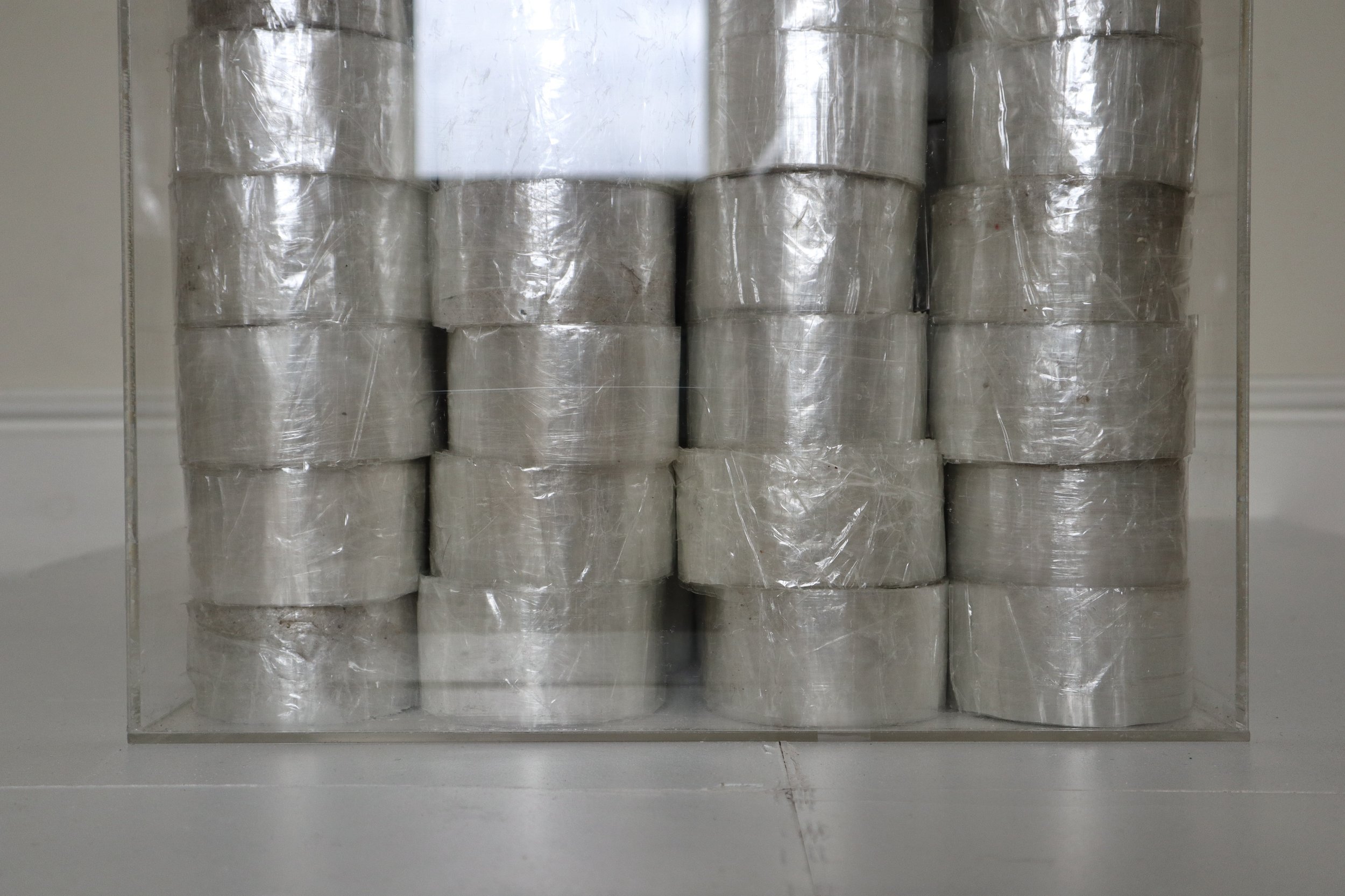



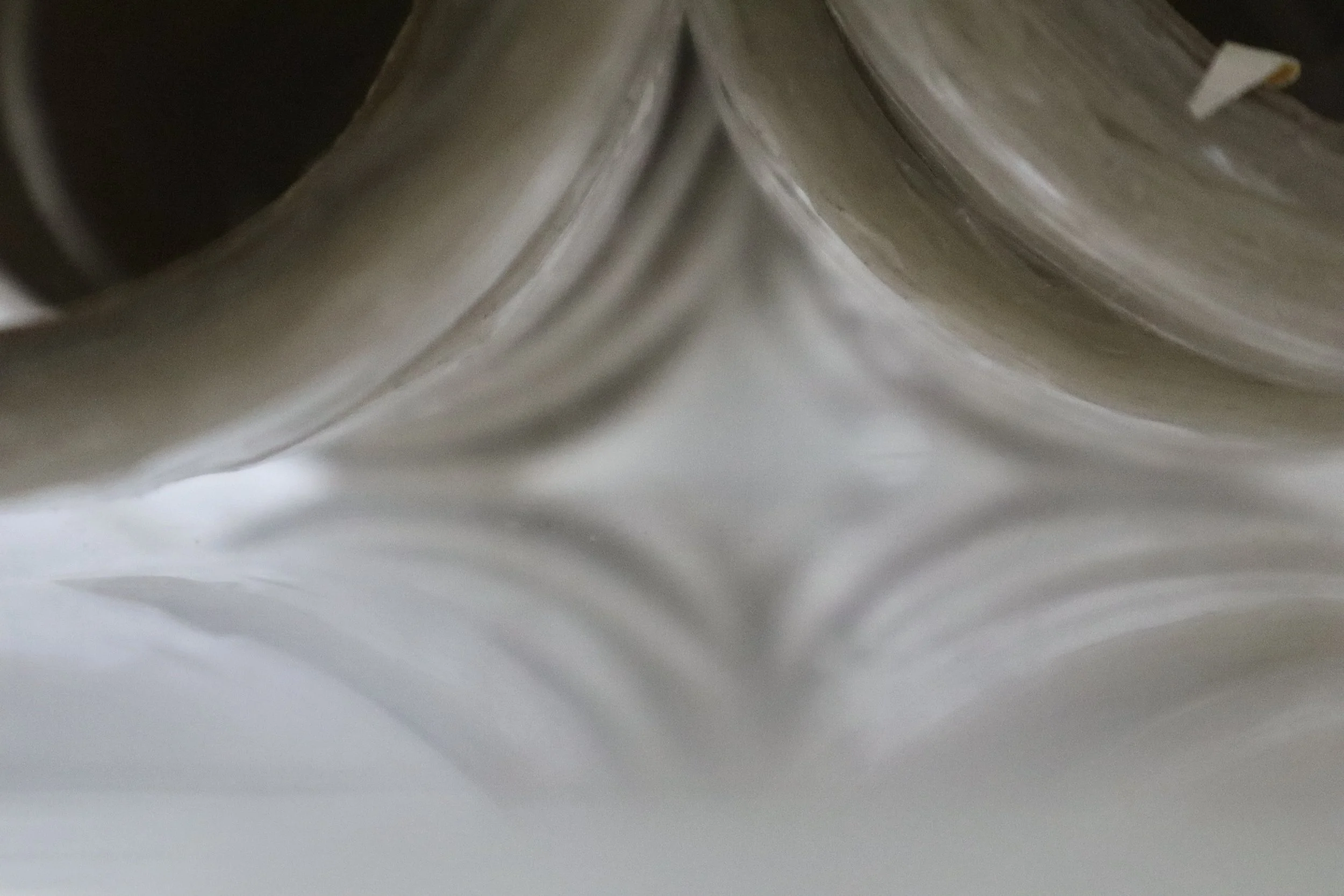
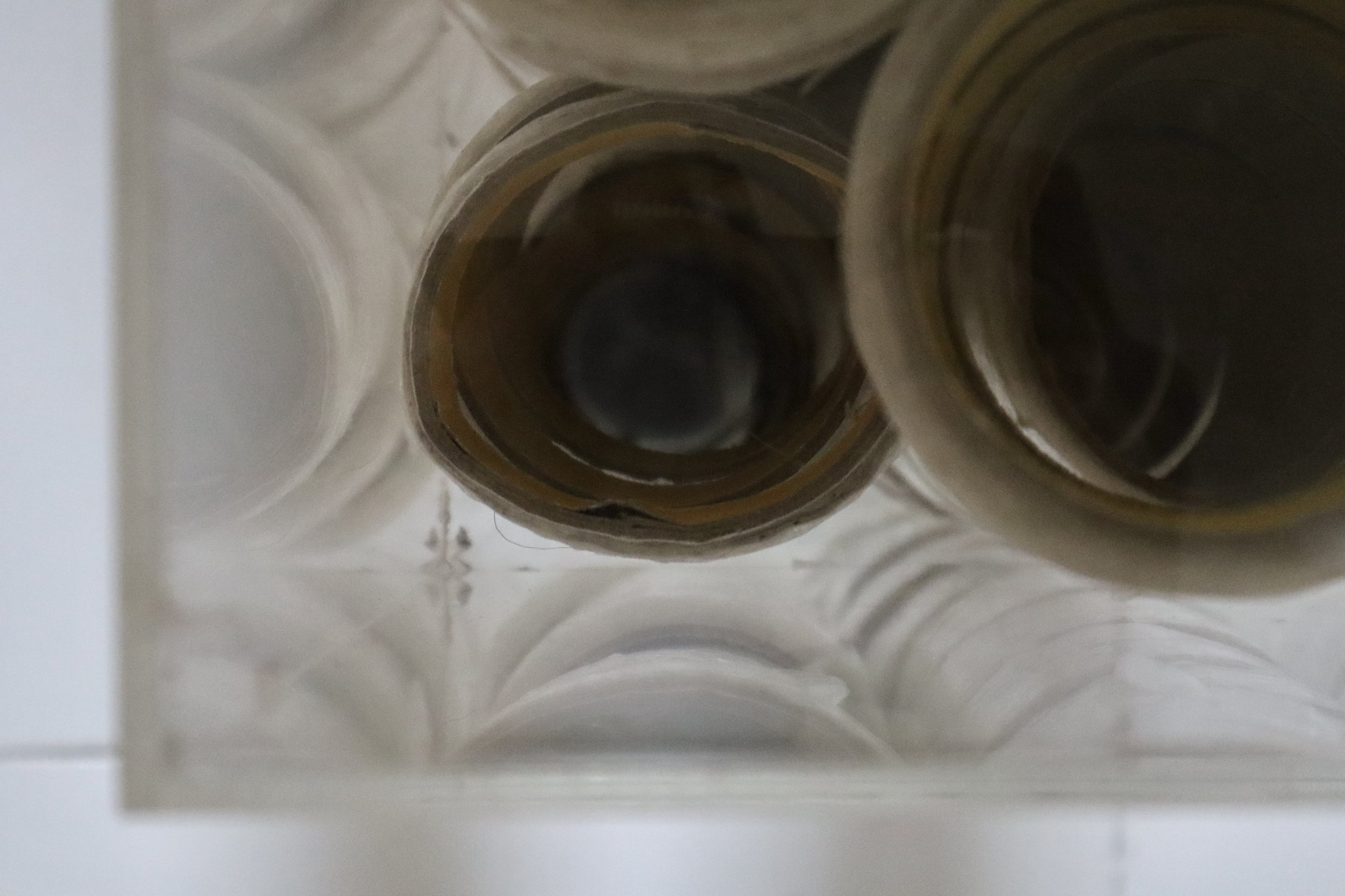
Documentation. 4.8038206872 (inversion). Studio installation and detail views; clear tape and pvc film, dust, hair, skin, fibres, cardboard spools, perspex cases. Dimensions: 41cm x 41cm x 72cm
4.8038206872 (residue)
Clear tape residue accumulated from returning the material objects once constructed from clear tape back to their origin, has been collected as a mass of tape off-cuts, shards, and dust. As a byproduct in this process, this mass of off-cuts has inadvertently become a work in its own right, elevating the residue; the plastic bag acting as the skin to this body of waste. Each small layer is a host, that carries multiple elements such as dust, hair and skin particles (skin cells, fingerprints and other remains of dna) that were accrued from its original process in making the objects, as well as additional marks and imprints of other's body's through performance, interaction or touch.
This piece and its counterpart, ‘4.8038206872 (inversion)' both allude to and share connotations to celluloid film stock - its components of film being spliced and put back together, as if they were picked up off the editing suite’s floor in the stages of editing, creating an imagined film from its shards and discarded remnants. Further accumulations, such as, cardboard dust and shavings, fibres from clothing, more hair, more skin etc., extends the piece's indexical and durational journey, and are now new companions, as they mingle in different shades of transparency.
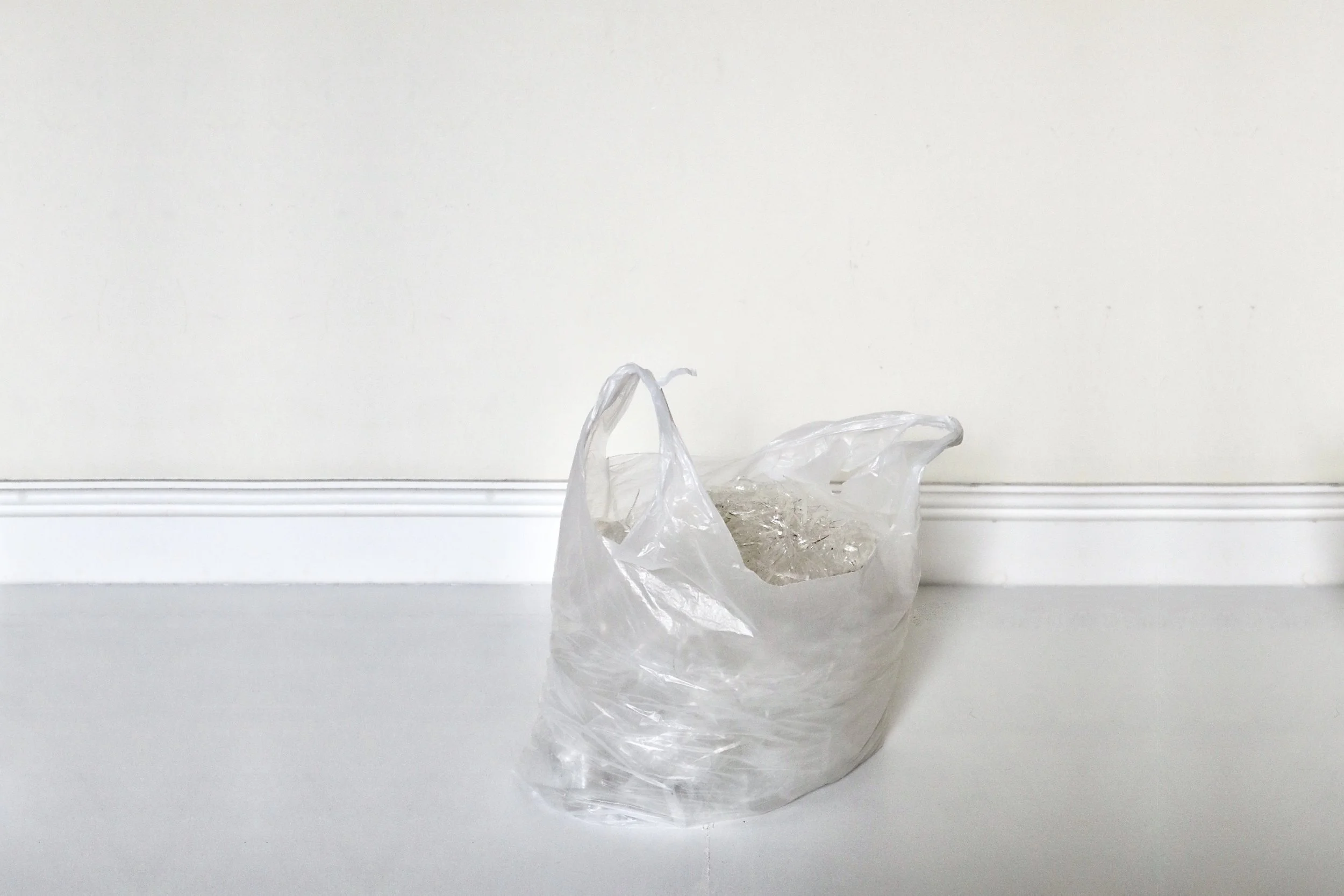
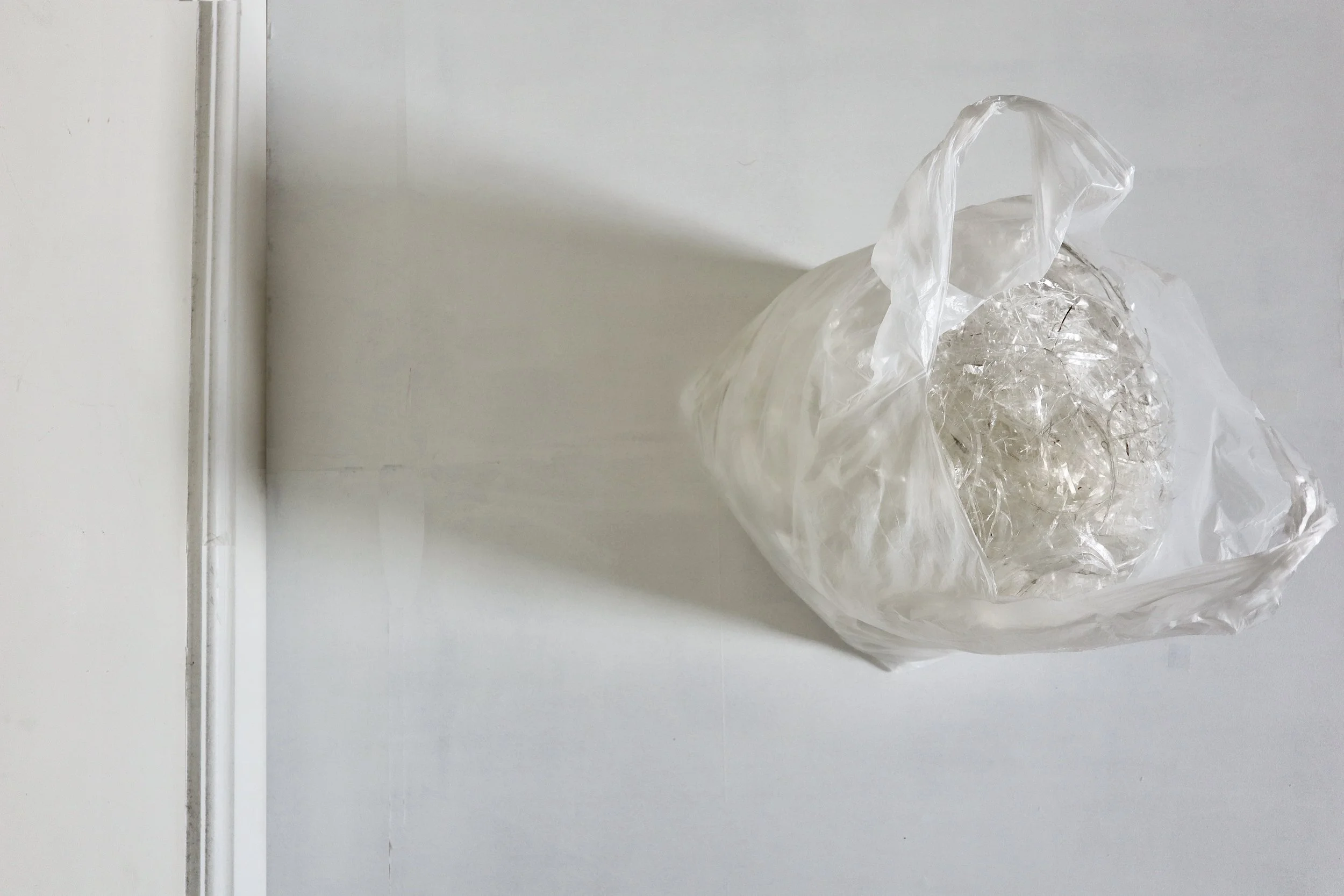








Documentation 4.8038206872 (residue). Studio installation and detail views; clear tape, pvc film, dust, hair, skin, fibres, plastic carrier bag. Dimensions: 40cm x 31cm x 26cm approx
4.8038206872 (damage)
In this journey of inverting, incising and accumulating residue of objects made and un-made in their doing and undoing, these now ‘un-objects’ have gone through their next phase in their transformation. In much of this small series of works, the physical presence of the body is invisible and only visible in its activities and actions that the body performs — the indexical, haptic gestures are being preserved that create ways of considering the body’s relationship to the materials.
In the instance of 4.8038206872 (damage), can be viewed as a form of flaying, occurring as a result in the damaging of the painstaking process of producing the original works, the undoing of this making, and to it’s re-making, to arrive at this point of it’s un-making. Many of the original works made connotations to the skin, and where the body interacted with this second skin, to end up being flayed through the handling, touching and retouching through its constant contact with human skin and its unhuman quality of this secondary skin. Added to this mix, is the further accumulation of dust, hair, skin particles and general debris from the studio surroundings, supplements the charge of individual layers that have undergone the varying junctures in its metamorphosis and disfigurement.








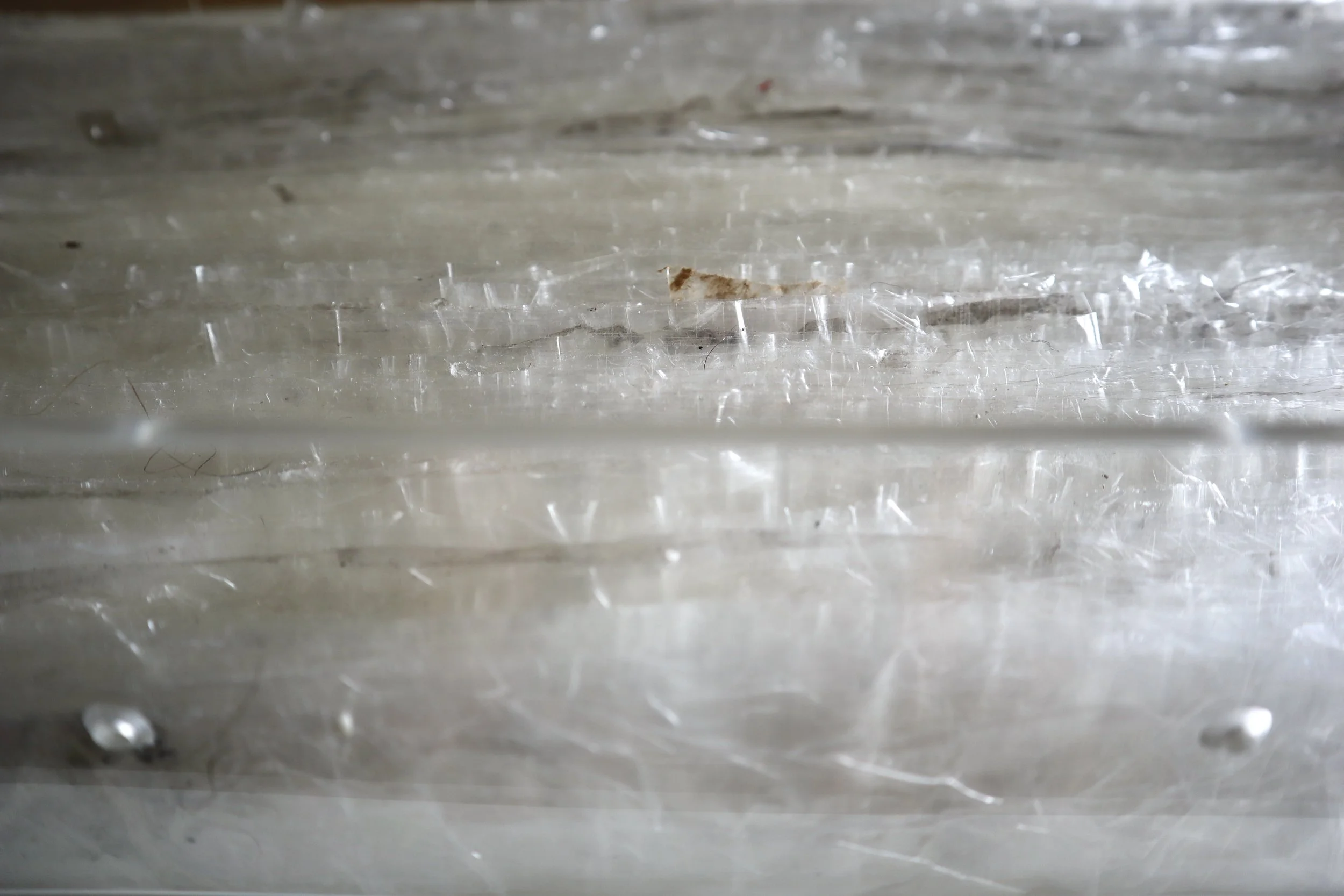

Documentation, 4.8038206872 (damage). Studio installation and detail views; clear tape and pvc film strips, cardboard dust, hair, skin, fibres, perspex. Dimensions: 200cm x 56cm x 25cm approx
About Conditions Programme
Conditions is artist-run, co-founded in 2018 by artist and educator Matthew Noel–Tod and artist and musician David Panos. The programme has been developed in collaboration with curator Sara Sassanelli since 2021. The aim is to build a long-term, sustainable, and independent environment for artists. The project proposes sharing knowledge as a resource and seeks to push aesthetic questions on the current notion and conditions of ‘contemporary art’.
Conditions is led by Matthew Noel-Tod, whose previous work in art education includes running the BA in Moving Image at the University of Brighton: a pioneering BA Programme in artists’ film and video.
For further details about the Conditions Programme and a list of all the Conditions Artists and Associates for 2024 -25, follow the link below:
